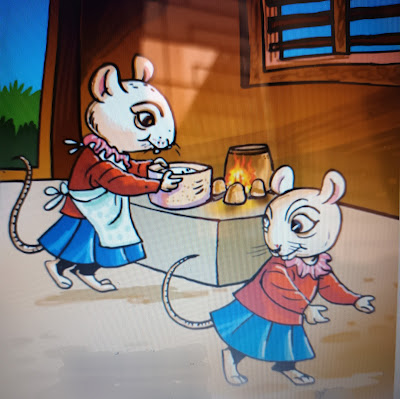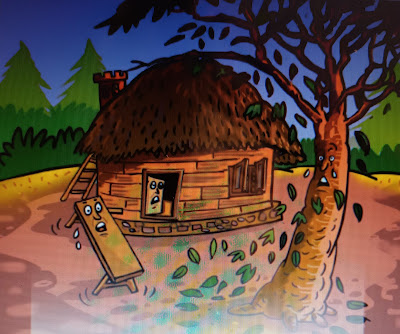Titty and Tatty
This tale belongs to a time out of memory when the butterflies slept among the wheat; when the elephants played on the flute; when the pigs flew; when the right-hand foot was squeezed into the left-hand shoe; when curly locks fed upon sugar and cream... Titty and Tatty were two little mice; and they were twins. These were more sisterly than their human counterparts anywhere in England. Except for a very minute red mole on Tatty's snout, the two little rodents were unmistakably identical.
They lived in a cottage of their own. Their parents had left them a substantial income to last a lifetime. So they didn't have to go picking and stealing, gnawing and nibbling, in some human kitchen or scullery. Their granary was always full. Though they could afford luxury they led a frugal life as most of the English mice did, in summer and winter alike, in those days.
It was their third birthday. Titty merrily squeaked to Tatty that she would make a special rice pudding to celebrate the occasion in style. So she put the pudding into the pot to boil.

Then Tatty scurried to the pantry, to get bread, butter and cheese. (No, those mousy sisters had no cellar. In fact, they never had a drop of wine in their entire life on earth. Though it was whispered in the mouse-world that some of their kind at times ventured to have a bristly lick of the beaded bubbles at the brim of a cup.) When Tatty returned to their common kitchen, a most tragic sight stunned her to standstill. For while she had been in the pantry, her sister had met with her fatal end. The boiling pot had tumbled over, and scalded poor Titty to a most painfully squealing death.
Tatty could do nothing but to sit down and mourn for the departed soul. (The mice in England then were all pitch black in colour. So they didn't have to put on black clothes for mourning.)
A three-legged stool in the kitchen asked the weeping sister: "Tatty, why do you weep?"
"Titty's dead", said Tatty, "and so I weep."
"Then", said the stool, "I'll jump." And the stool jumped. But it could raise only one of its legs; the other unwilling two stood dragging on the floor.
A broom in the corner of the room asked the hopping stool: "Stool, why d'you jump?"
"Titty's dead, and Tatty weeps; and so I jump."
"Then I'll sweep". And the broom began to sweep the room.
A door asked the sweeping broom: "Broom, why do you sweep?" "Titty's dead, and Tatty weeps; and the stool jumps, and so I sweep."
" Then I'll jar." And the door jarred ever so harshly.
A window asked the jarring door: "Door, why d'you jar?"
"Titty's dead, and Tatty weeps; and the stool jumps, and the broom sweeps, and so I jar."
"Then I'll creak". And the window creaked ever so gratingly.
The old bench outside the house asked the creaking window: "Window, why d'you creak?"
"Titty's dead, and Tatty weeps; and the stool jumps, and the broom sweeps, the door jars, and so I creak."
"Then I'll run around the house." And the old bench ran round the house.
The walnut-tree growing by the cottage asked the running bench: "Bench, why d'you run round the house?"
"Titty's dead, and Tatty weeps; and the stool jumps, and the broom sweeps, the door jars, the window creaks and so I run round the house."
"Then I'll shed my leaves." And the walnut-tree shed all its lovely green leaves.
The little bird that perched on a branch of the tree, asked the unleaving fruit-tree: "Walnut-tree, why d'you shed your goodly green leaves?"
"Titty's dead, and Tatty weeps; the stool jumps, the broom sweeps, the door jars, the window creaks, the old bench runs round the house and so I shed my leaves."
"Then I'll moult all my feathers." And the pretty little bird let all its fair feathers fall from its body, unto the very last of the fluffy downs, too.
A little girl was walking below, carrying a jug of milk for her people living next door. She asked the unfeathering bird, "Bird, why d'you moult all your feathers?"
"Titty's dead, and Tatty weeps; the stool jumps, the broom sweeps, the door jars, the window creaks, the old bench runs round the house, the walnut-tree sheds its green leaves, and so I moult all my feathers."
"Then I'll spill the milk." And the girl dropped the jug and spilt the milk. Now an old man had been hired by Titty and Tatty to re-thatch their cottage, to give it a new look. The man was standing on the top of the ladder, busy covering the roof with dried reeds and straw. He saw the girl drop the jug and spill the milk. He asked her, "Little girl, why do you spill the milk?"
"Titty's dead, and Tatty weeps; the stool jumps, the broom sweeps, the door jars, the window creaks, the old bench runs round the house, the walnut-tree sheds its green leaves, the pretty little girl moults all its feathers, and so I spilt the milk."
"Oh! Oh my!" exclaimed the old man. "My dearie little Titty gone! Then I'll tumble off the ladder and break my neck." And the kind old man tumbled off the ladder and broke his brittle neck.
In no time, the walnut-tree toppled down with a frightful crash. It upset the course of the old bench, and shook the Titty-Tatty cottage out of its balance. The cottage tottered and fell down. It knocked the creaking window out. The window unhinged the poor door. The door disturbed the broom. The broom overturned the stool. But that was not quite the end of these disasters and calamities.
The utmost pity was that poor little Tatty went down with her own house. And she was buried ingloriously beneath the ruins, not a squealing second allowed. Her sister's carrion lay close by, on the same floor...
That's the twin end of Titty and Tatty.
















